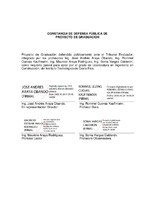Mostrar el registro sencillo del ítem
Desempeño de concreto permeable con sustitución parcial del material cementante por material vítreo y variaciones de tipo de cemento hidráulico
| dc.contributor.advisor | Cuevas-Kauffmann, Rommel | es |
| dc.contributor.author | Rojas-Ramos, Andrés | |
| dc.date.accessioned | 2020-11-04T23:00:23Z | |
| dc.date.available | 2020-11-04T23:00:23Z | |
| dc.date.issued | 2020 | |
| dc.identifier.uri | https://hdl.handle.net/2238/12241 | |
| dc.description | Proyecto de Graduación (Licenciatura en Ingeniería en Construcción) Instituto Tecnológico de Costa Rica, Escuela de Ingeniería en Construcción, 2020 | es |
| dc.description.abstract | En el presente trabajo se estudió el desempeño mecánico y permeable de cuatro diferentes concretos permeables, se utiliza cuatro tipos de cemento hidráulico diferentes y una sustitución de un 10% de estos por vidrio molido. En los concretos permeables realizados se usó cemento Portland de tipo CP II F, CP II Z, CP IV y CP V respectivamente. El vidrio empleado es transparente de tipo soda-cal y posee un tamaño de partícula de 75 μm. Este proyecto se efectuó en la Universidad Regional de Blumenau (FURB), Brasil, en alianza de investigación con el Tecnológico de Costa Rica (TEC). Se utilizó la metodología de dosificación de Nguyen, D. H. (2014). Una vez elaborados los concretos, se procedió a estudiar el comportamiento mecánico a compresión de cilindros, a flexión de prismas y el comportamiento permeable de placas. Los resultados muestran: el concreto con mejor comportamiento mecánico es el que utilizó CP V y 10 % de sustitución de vidrio molido, además, los cuatro concretos poseen un coeficiente de permeabilidad estadísticamente igual. | es |
| dc.description.abstract | On this work the mechanical and pervious performance of four different pervious concretes was studied, using four different hydraulic cements and a 10% substitution of them by grinded glass. Portland cement type CP II F, CP II Z, CP IV and CP V respectively were used in the previous concretes. The glass used is a transparent sodalime type on 75 μm particle size. This project was carried out at the Blumenau Regional University (FURB), Brazil, in a research alliance with the Technological Institute of Costa Rica (TEC). The method for the design of pervious concrete mix of Nguyen, D. H. (2014) was used. Once the concretes were made, a study of the mechanical compression behavior of cylinders, flexing prisms and the pervious behavior of plates began. The results show that the concrete with the best mechanical behavior is the one that used CP V and a 10% grinded glass substitution, besides, the four concretes have statistically the same pervious coefficient. | es |
| dc.language.iso | spa | es |
| dc.publisher | Instituto Tecnológico de Costa Rica | es |
| dc.rights | acceso abierto | es |
| dc.subject | Concreto permeable | es |
| dc.subject | Material cementante | es |
| dc.subject | Cemento | es |
| dc.subject | Material vítreo | es |
| dc.subject | Residuos | es |
| dc.subject | Vidrio | es |
| dc.subject | Cemento Portland | es |
| dc.subject | Permeabilidad | es |
| dc.subject | Pervious concrete | es |
| dc.subject | Cementing material | es |
| dc.subject | Waste | es |
| dc.subject | Glass | es |
| dc.subject | Portland cement | es |
| dc.subject | Permeability | es |
| dc.subject | Research Subject Categories::TECHNOLOGY::Materials science::Construction materials | es |
| dc.title | Desempeño de concreto permeable con sustitución parcial del material cementante por material vítreo y variaciones de tipo de cemento hidráulico | es |
| dc.type | proyecto fin de carrera | es |


